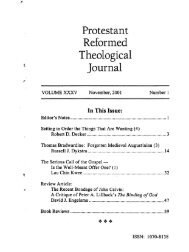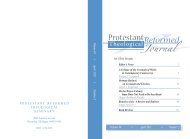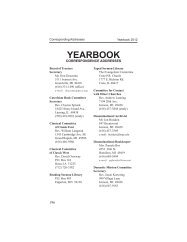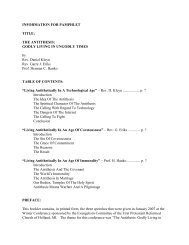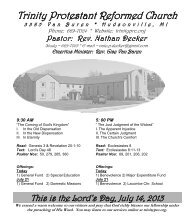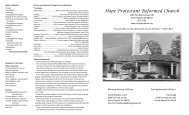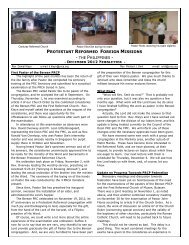November 2007 - Protestant Reformed Churches in America
November 2007 - Protestant Reformed Churches in America
November 2007 - Protestant Reformed Churches in America
You also want an ePaper? Increase the reach of your titles
YUMPU automatically turns print PDFs into web optimized ePapers that Google loves.
<strong>Protestant</strong> <strong>Reformed</strong> Theological Journal<br />
a man’s faith and sanctification, it spr<strong>in</strong>gs from that first error of his<br />
humiliation; if a man’s humiliation be false, and weak, and little, his<br />
faith is light, and his sanctification counterfeit. 55<br />
IV. Other Theologians<br />
Wilhelmus à Brakel (1635-1711) reveals a belief <strong>in</strong><br />
preparationism. He speaks of “preparatory convictions” 56 and<br />
urges the unconverted to enterta<strong>in</strong> hope because God “grants<br />
[them] conviction and a desire for repentance and salvation.” 57<br />
His advice is to attend diligently on the means. “You have reason<br />
to hope … Wait, therefore, for the least movement of the Spirit,<br />
respond to it, and be careful you do not resist it.” 58 However,<br />
such a desire, granted to some of the unconverted who use the<br />
means of grace, does not guarantee salvation. It is not a sign of<br />
regeneration, but may lead to it.<br />
Presbyterian theologian William G. T. Shedd (1820-1894) ascribes<br />
regeneration itself to the Holy Spirit but allows man to have<br />
some “agency … <strong>in</strong> the work of conviction which is preparatory<br />
or antecedent” to the new birth. 59 Shedd wants to be careful <strong>in</strong><br />
dist<strong>in</strong>guish<strong>in</strong>g the August<strong>in</strong>ian/Calv<strong>in</strong>istic idea of preparation from<br />
the Semi-Pelagian/Arm<strong>in</strong>ian/Synergistic version. The Calv<strong>in</strong>ist,<br />
writes Shedd, means by it “conviction of s<strong>in</strong>, guilt and helplessness.”<br />
The Arm<strong>in</strong>ian “denotes some fa<strong>in</strong>t desires and beg<strong>in</strong>n<strong>in</strong>gs<br />
of hol<strong>in</strong>ess <strong>in</strong> the natural man.” 60 This preparation, then, is not a<br />
“part of regeneration, but someth<strong>in</strong>g prior and antecedent to it.” 61<br />
Shedd next appeals to “common or prevenient grace.” The s<strong>in</strong>ner,<br />
writes Shedd, “moved and assisted” by this grace is able to<br />
perform certa<strong>in</strong> duties. Shedd lists some of these common grace-<br />
55. Shepard, Parable, p. 482.<br />
56. Wilhelmus à Brakel, The Christian’s Reasonable Service, vol. 2<br />
(Soli Deo Gloria Publications: Ligonier, PA, 1993), p. 249.<br />
57. à Brakel, Reasonable, vol. 2, p. 258.<br />
58. à Brakel, Reasonable, vol. 2, p. 259.<br />
59. William G. T. Shedd, Dogmatic Theology, vol. 2 (Charles<br />
Scribner’s Sons: New York, 1891), p. 512.<br />
60. Shedd, Theology, vol. 2, p. 512.<br />
61. Shedd, Theology, vol. 2, p. 512.<br />
72<br />
Vol. 41, No. 1



